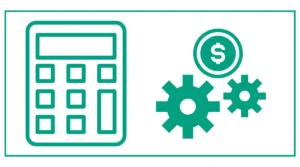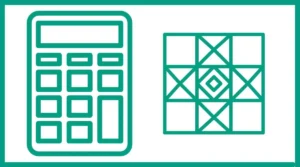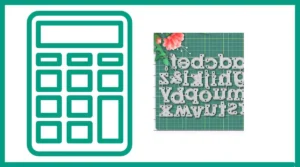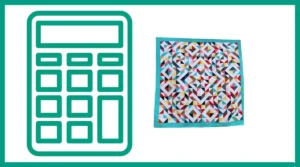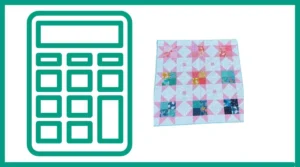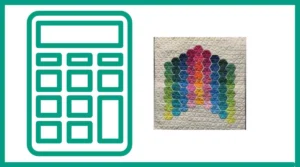The On-Point Quilt Calculator helps quilters determine the precise measurements needed for creating on-point quilt blocks. By inputting just two key measurements—the finished block size and the sashing width—this calculator provides the exact dimensions required for cutting corner and side-setting triangles.
Key Features of the Calculator
- Simple Input Fields: The calculator requires only two pieces of information:
- Finished block size (in inches)
- Sashing width (in inches)
- Instant Calculations: With a single click, the tool performs complex geometric calculations.
- Accurate Results: The calculator provides precise measurements for:
- Corner triangle square size
- Side triangle square size
- User-Friendly Interface: The clean, straightforward design makes it easy for quilters of all skill levels to use.
How to Use the On-Point Quilt Calculator
Using this tool is straightforward and can be broken down into three simple steps:
- Enter the Finished Block Size: Input the size of your finished quilt block in inches. This is the size of the block after it has been sewn into the quilt, not including seam allowances.
- Input the Sashing Width: If your design includes sashing between blocks, enter the width of the sashing in inches. If there’s no sashing, simply enter 0.
- Click “Calculate Triangle Sizes.”: Press the button to generate the results. The calculator will instantly display the required sizes for your corner and side triangle squares.
The Mathematics Behind On-Point Quilt Designs
Understanding the underlying geometry of on-point quilts can help quilters appreciate the value of this calculator. When a square block is rotated 45 degrees, it forms a diamond shape. To create a rectangular quilt from these diamond-shaped blocks, triangles are needed to fill in the spaces along the edges and corners.
Corner Triangles
Corner triangles are right-angled triangles that fill the four corners of the quilt. The size of these triangles is calculated using the formula:
Corner Triangle Size = (Effective Block Size / √2) + 0.875 inchesThe effective block Block Size is the sum of the finished block size and the sashing width.
Side Triangles
Side triangles are larger triangles used along the edges of the quilt. These are typically cut from squares and then divided diagonally. The size of the square needed for side triangles is calculated using:
Side Triangle Square Size = (Effective Block Size * √2) + 1.25 inchesThe additional 0.875 inches for corner triangles and 1.25 inches for side triangles account for seam allowances and ensure that the triangles will be large enough to trim to the exact size needed after sewing.
Practical Applications of the On-Point Quilt Calculator
To illustrate the practical value of this tool, let’s explore two examples:
Example 1: Basic On-Point Quilt
Suppose you’re creating an on-point quilt with 8-inch finished blocks and no sashing. Here’s how you would use the calculator:
- Enter “8” in the “Finished block size” field.
- Enter “0” in the “Sashing width” field.
- Click “Calculate Triangle Sizes”.
The calculator would return:
- Corner triangle square size: 6.53 inches
- Side triangle square size: 12.56 inches
This means you should cut your corner triangle squares to 6 5/8 inches and your side triangle squares to 12 5/8 inches, allowing for slight adjustments during the quilting process.
Example 2: On-Point Quilt with Sashing
Now, let’s consider a more complex design with 10-inch finished blocks and 2-inch sashing:
- Enter “10” in the “Finished block size” field.
- Enter “2” in the “shing width” field.
- Click “Calculate Triangle Sizes”.
The calculator would provide:
- Corner triangle square size: 9.10 inches
- Side triangle square size: 17.44 inches
In this case, you would cut your corner triangle squares to 9 1/8 inches and your side triangle squares to 17 1/2 inches.
Benefits of Using the On-Point Quilt Calculator
- Time-Saving: Eliminates the need for complex manual calculations, allowing quilters to focus on the creative aspects of their projects.
- Accuracy: Reduces the risk of measurement errors that could lead to ill-fitting pieces and frustration during the quilting process.
- Material Efficiency: Precise measurements help minimize fabric waste, an important consideration for both economic and environmental reasons.
- Confidence Boost: Knowing that your measurements are accurate can give you the confidence to tackle more complex, on-point designs.
- Accessibility: The online nature of the tool means it’s always available when you need it, whether you’re planning a project at home or shopping for fabric.
Tips for Success with On-Point Quilts
While the On Point Quilt Calculator significantly simplifies the planning process, here are some additional tips to ensure success with your on-point quilt projects:
- Double-Check Measurements: Always measure your fabric pieces after cutting to ensure accuracy.
- Consider Fabric Shrinkage: If you plan to wash your quilt, account for potential fabric shrinkage when selecting your block size.
- Test with a Sample Block: Before cutting all your fabric, create a test block to verify that your calculations result in the desired finished size.
- Pay Attention to Grain Lines: When cutting triangles, be mindful of fabric grain to maintain stability in your quilt.
- Use a Design Wall: Laying out your blocks on a design wall can help you visualize the final product and make any necessary adjustments before sewing.
